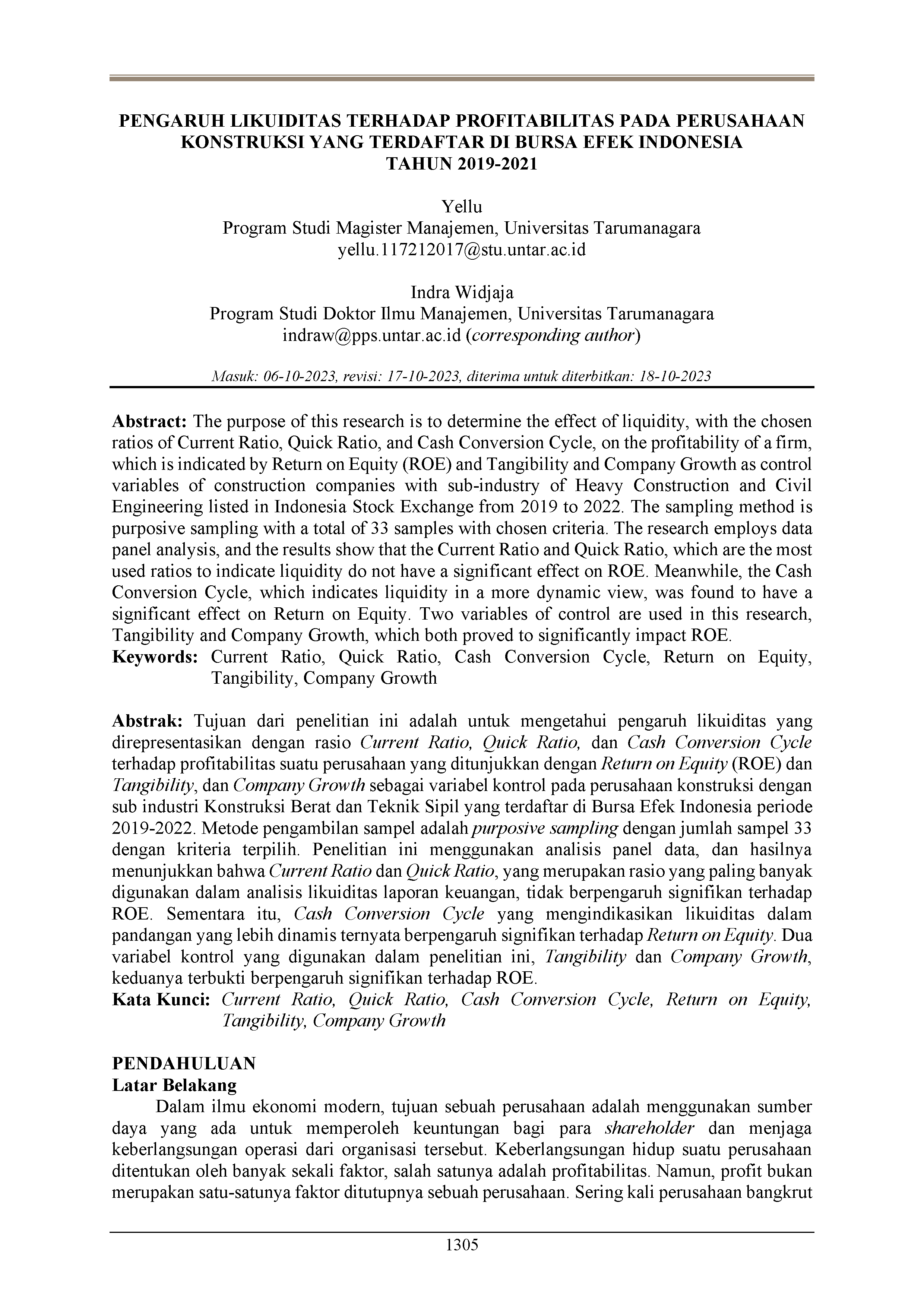Pengaruh likuiditas terhadap profitabilitas pada perusahaan konstruksi yang terdaftar di Bursa Efek Indonesia tahun 2019-2021
Main Article Content
Abstract
The purpose of this research is to determine the effect of liquidity, with the chosen ratios of Current Ratio, Quick Ratio, and Cash Conversion Cycle, on the profitability of a firm, which is indicated by Return on Equity (ROE) and Tangibility and Company Growth as control variables of construction companies with sub-industry of Heavy Construction and Civil Engineering listed in Indonesia Stock Exchange from 2019 to 2022. The sampling method is purposive sampling with a total of 33 samples with chosen criteria. The research employs data panel analysis, and the results show that the Current Ratio and Quick Ratio, which are the most used ratios to indicate liquidity do not have a significant effect on ROE. Meanwhile, the Cash Conversion Cycle, which indicates liquidity in a more dynamic view, was found to have a significant effect on Return on Equity. Two variables of control are used in this research, Tangibility and Company Growth, which both proved to significantly impact ROE.
Tujuan dari penelitian ini adalah untuk mengetahui pengaruh likuiditas yang direpresentasikan dengan rasio Current Ratio, Quick Ratio, dan Cash Conversion Cycle terhadap profitabilitas suatu perusahaan yang ditunjukkan dengan Return on Equity (ROE) dan Tangibility, dan Company Growth sebagai variabel kontrol pada perusahaan konstruksi dengan sub industri Konstruksi Berat dan Teknik Sipil yang terdaftar di Bursa Efek Indonesia periode 2019-2022. Metode pengambilan sampel adalah purposive sampling dengan jumlah sampel 33 dengan kriteria terpilih. Penelitian ini menggunakan analisis panel data, dan hasilnya menunjukkan bahwa Current Ratio dan Quick Ratio, yang merupakan rasio yang paling banyak digunakan dalam analisis likuiditas laporan keuangan, tidak berpengaruh signifikan terhadap ROE. Sementara itu, Cash Conversion Cycle yang mengindikasikan likuiditas dalam pandangan yang lebih dinamis ternyata berpengaruh signifikan terhadap Return on Equity. Dua variabel kontrol yang digunakan dalam penelitian ini, Tangibility dan Company Growth, keduanya terbukti berpengaruh signifikan terhadap ROE.
Article Details

This work is licensed under a Creative Commons Attribution-NonCommercial-ShareAlike 4.0 International License.
This work is licensed under a Jurnal Manajemen Bisnis dan Kewirausahaan Creative Commons Attribution-ShareAlike 4.0 International License.
References
Baños-Caballero, S., García-Teruel, P. J., & Martínez-Solano, P. (2010). Working capital management in SMEs. Accounting and Finance, 50(3), 511–527. https://doi.org/10.1111/j.1467-629X.2009.00331.x
Dawar, V. (2014). Agency theory, capital structure and firm performance: Some Indian evidence. Managerial Finance, 40(12), 1190–1206. https://doi.org/10.1108/MF-10-2013-0275
Eng, T. Y., & Spickett-Jones, J. G. (2009). An investigation of marketing capabilities and upgrading performance of manufacturers in mainland China and Hong Kong. Journal of World Business, 44(4), 463–475. https://doi.org/10.1016/j.jwb.2009.01.002
Fernando, J. (2023, May 24). Return on equity (ROE) calculation and what it means. Investopedia. https://www.investopedia.com/terms/r/returnonequity.asp
Fiador, V. (2016). Does corporate governance influence the efficiency of working capital management of listed firms: Evidence from Ghana. African Journal of Economic and Management Studies, 7(4), 482–496. https://doi.org/10.1108/AJEMS-08-2015-0096
García-Teruel, P. J., & Martínez-Solano, P. (2007). Effects of working capital management on SME profitability. International Journal of Managerial Finance, 3(2), 164–177. https://doi.org/10.1108/17439130710738718
Gujarati, D. N., & Porter, D. C. (2013). Dasar-dasar ekonometrika (E. Mardanugrah, S. Wardhani, & C. Mangunsong (eds.); 5th ed.). Salemba Empat.
Hart, O., & Moore, J. (1994). A theory of debt based on the inalienability of human capital. Quarterly Journal of Economics, 109(4), 841–879. https://doi.org/10.2307/2118350
Husna, A., & Satria, I. (2019). Effects of return on asset, debt to asset ratio, current ratio, firm size, and dividend payout ratio on firm value. International Journal of Economics and Financial Issues, 9(5), 50–54. https://doi.org/10.32479/ijefi.8595
Hussain, S., Ali Golam Hassan, A., Quddus, A., Rafiq, M., & Nguyen Van, C. (2021). Cash conversion cycle sensitivity by moderating role of exchange rates volatility on firm’s financial performance. Business: Theory and Practice, 22(2), 277–289. https://doi.org/10.3846/btp.2021.13147
Irawan, A., & Faturohman, T. (2015). A study of liquidity and profitability relationship: Evidence from Indonesian capital market. Proceedings of 31st The IIER International Conference, Bangkok, Thailand, 1–5. https://www.worldresearchlibrary.org/up_proc/pdf/48-143860541764-68.pdf
Jensen, M. C., & Meckling, W. H. (1976). Theory of the firm: Managerial behavior, agency costs and ownership structure. Journal of Financial Economics, 3(4), 305–360. https://doi.org/10.1016/0304-405X(76)90026-X
Lei, J., Qiu, J., & Wan, C. (2018). Asset tangibility, cash holdings, and financial development. Journal of Corporate Finance, 50, 223–242. https://doi.org/10.1016/j.jcorpfin.2018.03.008
Liberti, J. M., & Sturgess, J. (2018). The anatomy of a credit supply shock: Evidence from an internal credit market. Journal of Financial and Quantitative Analysis, 53(2), 547–579. https://doi.org/10.1017/S0022109017000837
Shanthirathna, M. H. T. N. (2019). Impact of liquidity management and capital structure on company performance: Evidence from New Zealand listed companies [Master Theses, Lincoln University]. https://hdl.handle.net/10182/11646
Shleifer, A., & Vishny, R. W. (1992). Liquidation values and debt capacity: A market equilibrium approach. The Journal of Finance, 47(4), 1343–1366. https://doi.org/10.2307/2328943
Talha, M., Christopher, S. B., & Kamalavalli, A. L. (2010). Sensitivity of profitability to working capital management: a study of Indian corporate hospitals. International Journal of Managerial and Financial Accounting, 2(3), 213–227. https://doi.org/10.1504/IJMFA.2010.034115
Tran, H., Abbott, M., & Jin Yap, C. (2017). How does working capital management affect the profitability of Vietnamese small- and medium-sized enterprises? Journal of Small Business and Enterprise Development, 24(1), 2–11. https://doi.org/10.1108/JSBED-05-2016-0070
Wang, Y. J. (2002). Liquidity management, operating performance, and corporate value: Evidence from Japan and Taiwan. Journal of Multinational Financial Management, 12(2), 159–169. https://doi.org/10.1016/S1042-444X(01)00047-0
Wasiuzzaman, S. (2015). Working capital and profitability in manufacturing firms in Malaysia: An empirical study. Global Business Review, 16(4), 545–556. https://doi.org/10.1177/0972150915581098
Wasiuzzaman, S. (2018). Determinants of liquidity in Malaysian SMEs: A quantile regression approach. International Journal of Productivity and Performance Management, 67(9), 1566–1584. https://doi.org/10.1108/IJPPM-12-2017-0354
Wasiuzzaman, S., & Arumugam, V. C. (2013). Determinants of working capital investment: A study of Malaysian public listed firms. Australasian Accounting, Business and Finance Journal, 7(2), 63–83. https://doi.org/10.14453/aabfj.v7i2.5
Widarjono, A. (2015). Statistika terapan dengan Excel & SPSS. UPP STIM YKPN.
Widjaja, I. (2011). Dampak ukuran degree of financial leverage, sales growth, dan size growth terhadap return harga saham. In Media Riset Bisnis & Manajemen (Vol. 11, Issue 2, pp. 126–139). https://doi.org/10.25105/mrbm.v11i2.1098
Widjaja, I., Arifin, A. Z., & Setini, M. (2020). The effects of financial literacy and subjective norms on saving behavior. Management Science Letters, 10(15), 3635–3642. https://doi.org/10.5267/j.msl.2020.6.030


